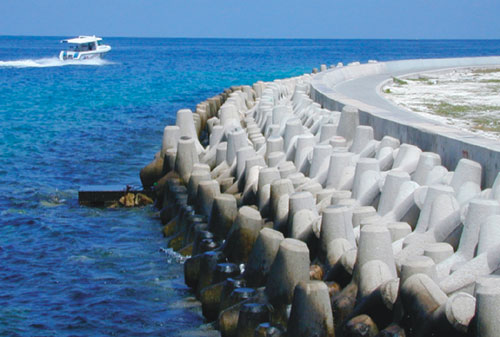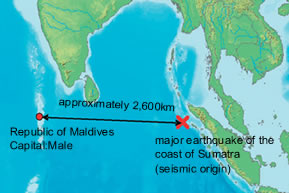Japan's Official Development Assistance White Paper 2005
Column II-2 Useful Japanese Contributions for the Major Earthquake off the Coast of Sumatra and the Tsunami in the Indian Ocean

Sea walls built around the Male Island

Male Island (Map: Ministry of Land Infrastructure and Transport)
Development of seawalls 1 and offshore breakwaters 2 on the Male Island
At the time of the Sumatra earthquake, Male Island, the capital and the largest island of the Republic of Maldives, was also hit by tsunami waves estimated to be as high as three meters. Nonetheless, seawalls and offshore breakwaters protected the island, which were built with Japan's assistance. While the city of Male was flooded, no one was killed and there were no major damages. Specifically, no houses were swept away.
Male Island is only one meter or so above sea level and has a flat landscape, where the seacoast was protected in the past simply by stacking corals. These factors caused the island to suffer from periodic floods due to tidal waves. Particularly, the cyclone in 1987 flooded one-third of the island, paralyzing the capital city.
After some field surveys and technical guidance, Japan decided to provide cooperation through grant aid in order to develop sea walls and so on. First, beginning in 1987, offshore breakwater was constructed over the following three years. Then, beginning in 1994, sea walls were built in turn for the west, east, and south sides of the island. In 2002, a sea wall for the northern shore, which is the main entranceway to the island, was constructed. Thus, the fifteen-year project of measures against tidal waves was completed. As a result, the entire Male Island is now protected by sea walls of an approximately six-kilometer circumference.
Japanese media reported that the seawalls built through Japan's assistance helped to contain the damages from the tsunami in the wake of the Sumatra earthquake. Reportedly, one local resident said, "Without Japan's assistance, Male Island would have disappeared." Furthermore, President Gayoom of the Republic of the Maldives also commented, "The seawalls built for Male Island through Japan's assistance saved the people of Male from the disaster."
Human network within the Aceh Province
The latest large-scale earthquake and tsunami caused catastrophic damages to Indonesia's Nanggroe Aceh Darussalam province, which is located near the epicenter. In addition, due to the escalation of armed conflicts over Aceh's separation and independence from Indonesia, a state of emergency was declared in May 2003 that restricted the entrance of foreigners, so the framework for accepting emergency assistance had been underdeveloped. In the wake of the disaster, the Indonesian government decided to accept foreign aid groups in the area. Nevertheless, donor countries including Japan were almost unable to secure a foundation for their activities, such as local lodging and transportation. Thus, they had to struggle eagerly to build support structures.
Under such circumstances, the JICA Indonesia Office received a phone call from Mr. Mikdar, living in the Aceh province. Mr. Mikdar is the head of the Aceh branch office of the JICA Youth Invitation Program. 3 By phone, he offered for the Japanese aid personnel to provide lodging, arrange for interpreters, and so on. Moreover, at the Syiah Kuala University, to which assistance had been provided through yen loan and other means in the past, there were many people who had studied in Japan. In various ways, these people assisted Japan throughout the cooperation process in the disaster-stricken areas. Such human networks developed over long years allowed Japan to provide emergency assistance smoothly, and the activities of the Japan Disaster Relief Medical Team have been appreciated by many local people in the area.


 Next Page
Next Page